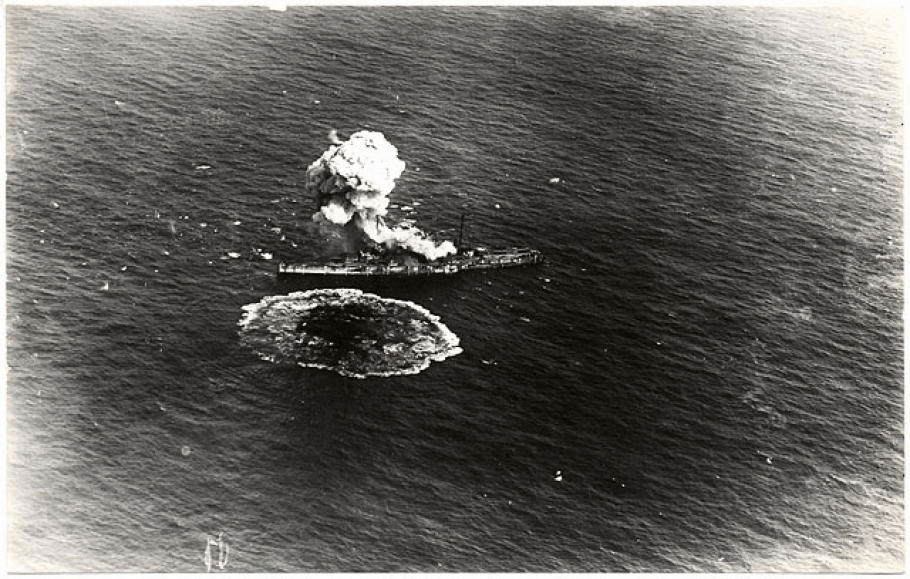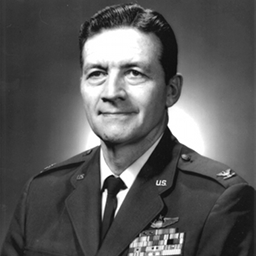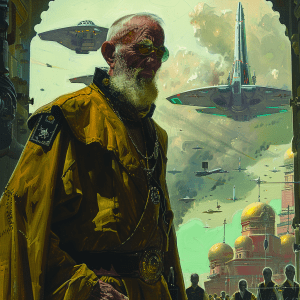“First they ignore you, then they laugh at you, then they fight you, then you win.”
The quote is commonly attributed to Mahatma Gandhi, the leader of the Indian independence movement against British rule, known for his philosophy of nonviolent resistance. However, there’s no recorded evidence that Gandhi actually said or wrote these exact words.
The quotes sentiment reflects the stages of a movement’s struggle towards success and acceptance. Initially, the movement might be ignored due to its perceived insignificance. As it gains visibility, it is ridiculed or dismissed as unrealistic or unimportant. Opposition grows as the movement becomes more influential, leading to direct conflict. Finally, if the movement’s ideas resonate widely and lead to change, it can be said to “win.”
This quote, regardless of its origin, captures the essence of perseverance and the potential for successful change despite initial resistance and challenges. Makes me ponder not only airpower but what’s next for the American military.
THE PROPHET
A prophet, in a religious context, is an individual believed to be chosen by a divine entity to deliver messages, guidance, warnings, or revelations from the divine to the people. These messages often pertain to spiritual insights, ethical teachings, future events, or social and religious reforms.
The role and significance of a prophet varies, but central to their function is the communication of divine will, the call to moral and spiritual renewal, and at times, the foretelling of future events. Prophets are often characterized by their deep spirituality, moral integrity, and sometimes the performance of miracles or signs to authenticate their message.
MILITARY PROPHETS
In a military or defense context, a “prophet” is not necessarily a prophet in the traditional religious sense but metaphorically represents an individual or a group with strategic foresight, ethical leadership, and the ability to guide others based on a deep understanding of moral and ethical principles. This manifests in several ways:
- Strategic Foresight: Similar to a prophet’s ability to foresee future events, in a military context, this is akin to a deep understanding of geopolitical dynamics, military strategy, and intelligence analysis. The prophet is able to predict potential conflicts, security challenges, and strategic opportunities, guiding military and defense planning.
- Ethical Leadership: A prophet’s call to moral and spiritual renewal can be paralleled with a leader who emphasizes ethical conduct, integrity, and moral decision-making within the military. This leader advocates for actions that not only comply with international laws and norms but also aligns with higher ethical standards, promoting the welfare of civilians, prisoners, and even adversaries.
- Cultural and Moral Advisor: In modern military operations, especially those involving diverse cultures and regions, individuals or teams akin to “prophets” might serve as cultural advisors. They provide insights into the ethical, cultural, and religious dimensions of operations, ensuring that actions understand culture and traditions.
- Innovators and Change Agents: Just as prophets in religious contexts often challenge the status quo and call for reform, innovative military leaders and thinkers play a similar role. They advocate for transformative strategies, new technologies, or reforms in military doctrine to address current and future challenges more effectively.
- Peacekeepers and Diplomats: In some scenarios, individuals who work towards conflict resolution, peacekeeping, and diplomacy might embody the spirit of a prophet by foreseeing potential resolutions to conflicts and guiding parties towards peace and reconciliation, often grounded in moral and ethical principles.
In all these cases, the “prophetic” role is more about embodying qualities of foresight, ethical guidance, and leadership rather than delivering divine messages. Such individuals or groups can significantly influence military strategy, operations, and culture, ensuring that actions taken are not only strategically sound but also ethically grounded.
PROPHETS OF AIRPOWER
In the context of airpower and military aviation, “prophets” are visionary leaders, theorists, or pioneers who foresaw the strategic and tactical importance of airpower, advocating for its development and innovative use in military operations. Here are a few notable figures who are considered airpower prophets:

- Giulio Douhet: An Italian general and airpower theorist, Giulio Douhet is one of the most influential figures in the development of airpower theory. In the early 20th century, he advocated for the decisive role of airpower in “future” conflicts, arguing that future wars would be won by the side that could dominate the air. Douhet’s seminal work, “The Command of the Air” (1921), outlined his vision for air warfare, including the strategic bombing of enemy infrastructure and cities to break the will of the enemy. His ideas were controversial at the time but later influenced air strategies in World War II and beyond.
- Billy Mitchell: Brigadier General William “Billy” Mitchell was a pioneering advocate for airpower in the United States. Serving in World War I, he observed the potential of aviation and became one of its strongest proponents between the world wars. Mitchell argued vigorously for the importance of airpower, particularly in naval operations, predicting the future significance of aircraft carriers and the vulnerability of battleships to aerial attack. His outspoken beliefs led to his court-martial in 1925, but his visions were largely vindicated in World War II, especially in the Pacific Theater.
- Hugh Trenchard, 1st Viscount Trenchard: Often referred to as the “Father of the Royal Air Force,” Trenchard was instrumental in establishing the RAF as an independent service separate from the British Army and Navy. Serving as its first chief, he advocated for the strategic use of airpower and was a key figure in developing the doctrine of strategic bombing. Trenchard believed in the morale effect of bombing on enemy populations and the importance of air superiority, laying the foundations for the RAF’s role in World War II, particularly in the Battle of Britain.
- Alexander P. de Seversky: A Russian-American aviator, inventor, and influential advocate of strategic airpower, Major Alexander P. de Seversky is best known for his book “Victory Through Air Power” (1942). This work argued for the decisive role of strategic bombing in warfare and influenced public opinion and military strategy during World War II. De Seversky’s ideas contributed to the development of long-range bombing strategies and the use of airpower as a separate and decisive element of military strategy, affecting the Allied approach to air warfare.
- Hap Arnold: General Henry H. “Hap” Arnold is a key figure in the development of the United States Air Force. As the only U.S. Air Force General to hold the rank of five-star General of the Air Force, Arnold played a pivotal role in the expansion and modernization of the USAAF (United States Army Air Forces) during World War II. He was a strong proponent of technological innovation in aviation and emphasized the importance of airpower in both strategic bombing and support of ground forces. Arnold’s vision and leadership helped to establish the foundation for the United States Air Force as an independent service after the war.
- John Boyd: A United States Air Force fighter pilot and military strategist, Colonel John Boyd was influential in the development of modern air combat theory and the broader field of military strategy. Boyd is best known for his “OODA loop” concept (Observe, Orient, Decide, Act), emphasizing the importance of decision-making speed and adaptability in combat situations, including aerial engagements. Although initially applied to air combat, the OODA loop has broader implications in military strategy and has been adopted in various fields. Boyd also played a crucial role in the design of the F-15 and F-16 fighter jets, advocating for agility and energy-maneuverability theory over sheer power and speed.
These individuals were ahead of their time in understanding the potential of airpower and worked tirelessly to develop and promote their visions, facing skepticism and resistance along the way. Their foresight and advocacy set the stage for the critical role airpower would play in modern military strategy and operations.
‘A prophet is not without honor except in his own town and in his own home.'”
The sentiment that “a prophet is not without honor except in his own hometown” is expressed in several places in the New Testament, reflecting Jesus’ experiences of rejection in Nazareth, where he grew up. Here are the specific references:
- Matthew 13:57: “And they took offense at him. But Jesus said to them, ‘A prophet is not without honor except in his own town and in his own home.'”
- Mark 6:4: Jesus said to them, “A prophet is not without honor except in his own town, among his relatives and in his own home.”
- Luke 4:24: “Truly I tell you,” he continued, “no prophet is accepted in his hometown.”
- John 4:44: (While this verse does not directly include the phrase, it conveys a similar idea) “Now Jesus himself had pointed out that a prophet has no honor in his own country.”
These passages reflect a common theme in the Gospels where Jesus, despite his teachings and miracles, faced skepticism and rejection from those who knew him from his early life. This highlights the broader challenge that prophets and reformers often face when their new ideas and changes are resisted by those most familiar with them.
BUT…WHY?
The concept that “a prophet is not without honor except in his own hometown” has been examined through various academic lenses, including sociology, anthropology, and psychology. While the phrase originates from a biblical context, the underlying idea that new ideas or changes are often met with resistance by those most familiar with the originator can be observed in various social and cultural settings. This phenomenon can be related to several theories and concepts in the social sciences:
- Status Quo Bias: This is a psychological preference for the current state of affairs. People tend to resist changes because they value what is familiar to them. Innovators or “prophets” challenge the status quo, which can lead to resistance, especially from those who feel they have the most to lose.
- Social Identity Theory: People define themselves by the groups to which they belong. When someone from within the group seeks to disrupt or change its norms or beliefs, it can be perceived as a threat to the group’s identity, leading to resistance. This can be particularly pronounced in the person’s hometown or original social group, where their identity is strongly tied to established norms.
- Cognitive Dissonance: This theory suggests that people experience discomfort when they hold two or more contradictory beliefs, ideas, or values. When a “prophet” presents ideas that conflict with the established beliefs of their community, it creates cognitive dissonance, leading to resistance as the community attempts to minimize this discomfort.
- In-Group/Out-Group Dynamics: People tend to categorize others as belonging to either an in-group (with which they identify) or an out-group (which they see as different from themselves). A prophet, by advocating for change, may be viewed as aligning with out-group ideals, even if they come from within the community, leading to rejection.
- Familiarity Breeds Contempt: This adage suggests that extensive knowledge of someone can lead to a loss of respect for them. In the context of a prophet in their hometown, those who have known the individual since childhood may find it hard to reconcile their preconceived notions of the person with the individual’s later claims of insight or revelation.
While direct studies specifically validating the “prophet in his hometown” phenomenon might be limited, these and other social science theories provide a framework for understanding why individuals who seek to bring about change, especially radical or reformative change, might face particular challenges within their own communities or groups. Scholarly research in fields like innovation diffusion, social psychology, and cultural anthropology often touches on these themes, offering insights into the complex dynamics of social change and resistance.
WHERE HAVE THE PROPHETS GONE?
The concept of “AirPower prophets” in the modern era might not align directly with the notion of the early 20th-century visionaries who were pioneering entirely new domains of warfare. The evolution of airpower and the advent of space and cyber domains have somewhat blurred the lines, making contemporary military innovation a more collaborative and multidisciplinary endeavor. However, there are still individuals who push the boundaries of airpower through innovative concepts, technological advancement, and strategic foresight. Here’s an exploration of the idea in the modern context:
Modern Context of AirPower Visionaries:
- Technological Innovators: In the current era, those who could be considered “prophets” of airpower might be at the forefront of technological innovation, such as unmanned aerial vehicles (UAVs), stealth technology, hypersonic weapons, and AI integration into air combat systems. These individuals often work within defense industries, research institutions, or military research and development sectors.
- Strategic Theorists: Some military strategists and defense analysts might be seen as modern prophets of airpower by proposing new doctrines or strategies that leverage airpower alongside space and cyber capabilities to maintain dominance or achieve strategic objectives in innovative ways.
- Advocates for Space Power: As the frontier of airpower extends into space, individuals advocating for the integration of space capabilities with traditional airpower, emphasizing the importance of space dominance as an extension of air superiority, might be seen as the new prophets of airpower.
Challenges for Modern Visionaries:
- Institutional Resistance: Visionaries often face resistance from established institutions and doctrines. However, modern military organizations have become more adaptive and open to innovation, especially given the rapid pace of technological change. Visionaries might find more avenues to test and implement their ideas, although bureaucratic and operational inertia can still pose significant hurdles.
- Collaborative Environment: Modern defense innovation is increasingly collaborative, involving international partnerships, private defense contractors, and government agencies. While this environment can foster innovation, it might dilute the recognition of individual contributions compared to the more distinct influence of early airpower theorists.
- Ethical and Legal Considerations: With the advent of technologies like drones and autonomous weapons systems, modern airpower visionaries must navigate complex ethical and legal landscapes. Their proposals and innovations are scrutinized not just for effectiveness but for their alignment with international law and ethical standards of warfare.
Impact on Modern Visionaries:
An individual proposing groundbreaking theories or technologies today might not face the same level of personal risk (such as court-martial or ostracization) as early figures like Billy Mitchell. Instead, they might encounter professional challenges, such as securing funding and institutional support for their projects. Success in the modern era is often contingent upon an individual’s ability to navigate complex bureaucratic structures, build coalitions, and align their innovations with broader strategic goals.
Modern “AirPower prophets” might gain recognition through successful implementation of their ideas, leading to advancements in military capabilities. They could influence future doctrines and shape the strategic landscape, albeit in a more collaborative and less individually focused manner than their early 20th-century counterparts.






